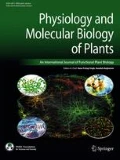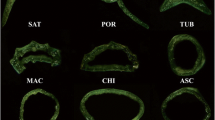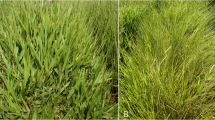Abstract
Miscanthus species are perennial C4 grasses that are considered promising energy crops because of their high biomass yields, excellent adaptability and low management costs. Miscanthus lutarioriparius and Miscanthus sacchariflorus are closely related subspecies that are distributed in different habitats. However, there are only a few reports on the mechanisms by which Miscanthus adapts to different environments. Here, comparative transcriptomic and morphological analyses were used to study the evolutionary adaptation of M. lutarioriparius and M. sacchariflorus to different habitats. In total, among 7586 identified orthologs, 2060 orthologs involved in phenylpropanoid biosynthesis and plant hormones were differentially expressed between the two species. Through an analysis of the Ka/Ks ratios of the orthologs, we estimated that the divergence time between the two species was approximately 4.37 Mya. In addition, 37 candidate positively selected orthologs (PSGs) that played important roles in the adaptation of these species to different habitats were identified. Then, the expression levels of 20 PSGs in response to flooding and drought stress were analyzed, and the analysis revealed significant changes in their expression levels. These results facilitate our understanding of the evolutionary adaptation to habitats and the speciation of M. lutarioriparius and M. sacchariflorus. We hypothesise that lignin synthesis genes are the main cause of the morphological differences between the two species. In summary, the plant nonspecific phospholipase C gene family and the receptor-like protein kinase gene family played important roles in the evolution of these two species.



Similar content being viewed by others
Availability of data and material
The sequencing raw data from 6 RNA-Seq libraries were deposited on the Sequence Read Archive from NCBI under SRA accession: SRP158951 and SRP190160. Data are available here:
References
Altenhoff AM, Dessimoz C (2009) Phylogenetic and functional assessment of orthologs inference projects and methods. PLoS Comput Biol 5:e1000262
Ayadi M, Hanana M, Kharrat N, Merchaoui H, Marzoug RB, Lauvergeat V, Rebai A, Mzid R (2016) The wrky transcription factor family in citrus: Valuable and useful candidate genes for citrus breeding. Appl Biochem Biotechnol 180:516–543
Chen J, Yin Y (2017) Wrky transcription factors are involved in brassinosteroid signaling and mediate the crosstalk between plant growth and drought tolerance. Plant Signal Behav 12:e1365212
Chen X, Li C, Wang H, Guo Z (2019) Wrky transcription factors: evolution, binding, and action. Phytopathol Res 1:1–5
Cheng J, Fan H, Li L, Hu B, Liu H, Liu Z (2018) Genome-wide identification and expression analyses of rpp13-like genes in barley. BioChip J 12:102–113
Clifton-Brown J, Hastings A, Mos M, McCalmont JP et al (2017) Progress in upscalingmiscanthusbiomass production for the european bio-economy with seed-based hybrids. GCB Bioenergy 9:6–17
Dohleman FG, Heaton EA, Leakey AD, Long SP (2009) Doe’s greater leaf-level photosynthesis explain the larger solar energy conversion efficiency of miscanthus relative to switchgrass? Plant Cell Environ 32:1525–1537
El-Esawi MA, Al-Ghamdi AA, Ali HM, Ahmad M (2019) Overexpression of atwrky30 transcription factor enhances heat and drought stress tolerance in wheat (triticum aestivum l.). Genes 10:163
Elmer KR, Fan S, Gunter HM et al (2010) Rapid evolution and selection inferred from the transcriptomes of sympatric crater lake cichlid fishes. Mol Ecol 19:197–211
Gao F, Yang F, Zhou H, Sun Q, Zhang Y, Brown MA (2014) Evaluation of processing technology for triarrhena sacchariflora (maxim.) nakai for ethanol production. PloS one 9:e114399
Gao F, Wang N, Li H et al (2016) Identification of drought-responsive microRNAs and their targets in Ammopiptanthus mongolicus by using high-throughput sequencing. Sci Rep 6:34601
Gao F, Li H, Xiao Z, Wei C, Feng J, Zhou Y (2017) De novo transcriptome analysis of ammopiptanthus nanus and its comparative analysis with a. Mongolicus Trees 32:287–300
Grabherr MG, Haas BJ et al (2011) Full-length transcriptome assembly from RNA-Seq data without a reference genome. Nat Biotechnol 29(7):644–652
Gupta P, Nutan KK, Singla-Pareek SL, Pareek A (2017) Abiotic stresses cause differential regulation of alternative splice forms of gata transcription factor in rice. Front Plant Sci 8:1944
He GH, Xu JY, Wang YX, Liu JM, Li PS, Chen M, Ma YZ, Xu ZS (2016) Drought-responsive wrky transcription factor genes tawrky1 and tawrky33 from wheat confer drought and/or heat resistance in arabidopsis. BMC Plant Biol 16:116
Heaton EA, Dohleman FG, Long SP (2008) Meeting us biofuel goals with less land: the potential of miscanthus. Glob Change Biol 14:2000–2014
Iseli C, Jongeneel CV, Bucher P (1999) ESTScan: a program for detecting, evaluating, and reconstructing potential coding regions in EST sequences. ISMB 99:138–148
Jia Y, Liu ML, Yue M, Zhao Z, Zhao GF, Li ZH (2017) Comparative transcriptome analysis reveals adaptive evolution of notopterygium incisum and notopterygium franchetii, two high-alpine herbal species endemic to china. Molecules 22:1158
Krckova Z, Brouzdova J, Danek M, Kocourkova D, Rainteau D, Ruelland E, Valentova O, Pejchar P, Martinec J (2015) Arabidopsis non-specific phospholipase c1: characterization and its involvement in response to heat stress. Front Plant Sci 6:928
Lee WC, Kuan WC (2015) Miscanthus as cellulosic biomass for bioethanol production. Biotechnol J 10:840–854
Lehti-Shiu MD, Shiu SH (2012) Diversity, classification and function of the plant protein kinase superfamily. Philos Trans R Soc Lond B Biol Sci 367:2619–2639
Levy ED, Michnick SW, Landry CR (2012) Protein abundance is key to distinguish promiscuous from functional phosphorylation based on evolutionary information. Philos Trans R Soc Lond B Biol Sci 367:2594–2606
Li B, Dewey CN (2011) RSEM: accurate transcript quantification from RNA-Seq data with or without a reference genome. BMC Bioinform 12:323
Li L, Stoeckert CJ, Roos DS (2003) OrthoMCL: Identification of ortholog groups for eukaryotic genomes. Genom Res 13:2178–2189
Li X, Liao H, Fan C, Hu H, Li Y, Li J, Yi Z, Cai X, Peng L, Tu Y (2016) Distinct geographical distribution of the miscanthus accessions with varied biomass enzymatic saccharification. PloS one 11:e0160026
Li X, Salman A, Guo C, Yu J, Cao S, Gao X, Li W, Li H, Guo Y (2018) Identification and characterization of lrr-rlk family genes in potato reveal their involvement in peptide signaling of cell fate decisions and biotic/abiotic stress responses. Cells 7:120
Li SS, Zhou HF, Chen WL, Yan J, Cai Z, Wei RX, Chen CH, Han B, Li JQ, Sang T, Ge S (2019) Population genetics and evolutionary history of miscanthus species in china. J Syst Evol 57:530–542
Liu X, Song Y, Xing F, Wang N, Wen F, Zhu C (2016) Ghwrky25, a group i wrky gene from cotton, confers differential tolerance to abiotic and biotic stresses in transgenic nicotiana benthamiana. Protoplasma 253:1265–1281
Lu J, Peatman E, Tang H, Lewis J, Liu Z (2012) Profiling of gene duplication patterns of sequenced teleost genomes evidence for rapid lineage-specific genome expansion mediated by recent tandem duplications. BMC Genomics 13:1–10
Nabholz B, Sarah G, Sabot F, Ruiz M, Adam H, Nidelet S, Ghesquiere A, Santoni S, David J, Glemin S (2014) Transcriptome population genomics reveals severe bottleneck and domestication cost in the african rice (oryza glaberrima). Mol Ecol 23:2210–2227
Niu CF, Wei W, Zhou QY, Tian AG, Hao YJ, Zhang WK, Ma B, Lin Q, Zhang ZB, Zhang JS, Chen SY (2012) Wheat wrky genes tawrky2 and tawrky19 regulate abiotic stress tolerance in transgenic arabidopsis plants. Plant Cell Environ 35:1156–1170
Peret B, Middleton AM, French AP, Larrieu A, Bishopp A, Njo M, Wells DM, Porco S, Mellor N, Band LR, Casimiro I, Kleine-Vehn J, Vanneste S, Sairanen I, Mallet R, Sandberg G, Ljung K, Beeckman T, Benkova E, Friml J, Kramer E, King JR, De Smet I, Pridmore T, Owen M, Bennett MJ (2013) Sequential induction of auxin efflux and influx carriers regulates lateral root emergence. Mol Syst Biol 9:699
Peters C, Kim SC, Devaiah S, Li M, Wang X (2014) Non-specific phospholipase c5 and diacylglycerol promote lateral root development under mild salt stress in Arabidopsis. Plant Cell Environ 37:2002–2013
Pokotylo I, Pejchar P, Potocky M, Kocourkova D, Krckova Z, Ruelland E, Kravets V, Martinec J (2013) The plant non-specific phospholipase c gene family. Novel competitors in lipid signalling. Prog Lipid Res 52:62–79
Rahi ML, Mather PB, Ezaz T, Hurwood DA (2019) The molecular basis of freshwater adaptation in prawns: Insights from comparative transcriptomics of three macrobrachium species. Genome Biol Evol 11:1002–1018
Robinson MD et al (2010) edgeR: a Bioconductorpackage for differential expression analysis of digital gene expression data. Bioinformatics 26(1):139–14
Schuler MA, Duan H, Bilgin M, Ali S (2006) Arabidopsis cytochrome p450s through the looking glass: a window on plant biochemistry. Phytochem Rev 5:205–237
Sharma R, Singh G, Bhattacharya S, Singh A (2018) Comparative transcriptome meta-analysis of arabidopsis thaliana under drought and cold stress. PloS one 13:e0203266
Shen X, Wan S, Colin C, Tada R, Shi X, Pei W, Li A (2018) Increased seasonality and aridity drove the C4 plant expansion in Central Asia since the Miocene-Pliocene boundary. Earth Planet Sci Lett 502:74–83
Sinha AK, Jaggi M, Raghuram B, Tuteja N (2011) Mitogen-activated protein kinase signaling in plants under abiotic stress. Plant Signal Behav 6:196–203
Song Z, Xu Q, Lin C, Tao C, Zhu C, Xing S, Fan Y, Liu W, Yan J, Li J, Sang T (2017) Transcriptomic characterization of candidate genes responsive to salt tolerance of Miscanthus energy crops. GCB Bioenergy 9:1222–1237
Song H, Sun W, Yang G, Sun J (2018) Wrky transcription factors in legumes. BMC Plant Biol 18:243
Sorensen I, Domozych D, Willats WG (2010) How have plant cell walls evolved? Plant Physiol 153:366–372
Stroud JT, Losos JB (2016) Ecological opportunity and adaptive radiation. Annu Rev Ecol Evol Syst 47:507–532
Sun Q, Lin Q, Yi Z-L, Yang Z-R, Zhou F-S (2010) A taxonomic revision of miscanthussl (poaceae) from china. Bot J Linn Soc 164:178–220
Tao SQ, Cao B, Tian CM, Liang YM (2017) Comparative transcriptome analysis and identification of candidate effectors in two related rust species (gymnosporangium yamadae and gymnosporangium asiaticum). BMC Genomics 18:651
Timotijevic GS, Milisavljevic M, Radovic SR, Konstantinovic MM, Maksimovic VR (2010) Ubiquitous aspartic proteinase as an actor in the stress response in buckwheat. J Plant Physiol 167:61–68
Turupcu A, Almohamed W, Oostenbrink C, Seifert GJ (2018) A speculation on the tandem fasciclin 1 repeat of fla4 proteins in angiosperms. Plant Signal Behav 13:e1507403
Wang J, Li C, Yao X, Liu S, Zhang P, Chen K (2017a) The antarctic moss leucine-rich repeat receptor-like kinase (pnlrr-rlk2) functions in salinity and drought stress adaptation. Polar Biol 41:353–364
Wang J, Chen Z, Jin S, Hu Z, Huang Y, Diao Y (2017b) Development and characterization of simple sequence repeat (SSR) markers based on a full-length cDNA library of Napier Grass (Pennisetum purpureum Schum). Genes Genomics 39(12):1297–1305
Wang Z, Hong X, Hu K, Wang Y, Wang X, Du S, Li Y, Hu D, Cheng K, An B, Li Y (2017c) Impaired magnesium protoporphyrin ix methyltransferase (chlm) impedes chlorophyll synthesis and plant growth in rice. Front Plant Sci 8:1694
Wang L, Yao L, Hao X, Li N, Qian W, Yue C, Ding C, Zeng J, Yang Y, Wang X (2018) Tea plant sweet transporters: Expression profiling, sugar transport, and the involvement of cssweet16 in modifying cold tolerance in Arabidopsis. Plant Mol Biol 96:577–592
Wang J, Sun H, Sheng J, Jin S, Zhou F, Hu Z, Diao Y (2019) Transcriptome, physiological and biochemical analysis of Triarrhena sacchariflora in response to flooding stress. BMC Genet 20(1):88
Weng JK, Chapple C (2010) The origin and evolution of lignin biosynthesis. New Phytol 187:273–285
Xiao YG, Sun QB, Kang XJ, Chen CB, Ni M (2016) Short hypocotyl under blue1 or haiku2 mixepression alters canola and Arabidopsis seed development. New Phytol 209:636–649
Xu Q, Xing S, Zhu C, Liu W, Fan Y, Wang Q, Song Z, Yang W, Luo F, Shang F, Kang L, Chen W, Yan J, Li J, Sang T (2015) Population transcriptomics reveals a potentially positive role of expression diversity in adaptation. J Integr Plant Biol 57:284–299
Xu Q, Zhu C, Fan Y, Song Z, Xing S, Liu W, Yan J, Sang T (2016) Population transcriptomics uncovers the regulation of gene expression variation in adaptation to changing environment. Sci Rep 6:25536
Xu G, Li M, Zhang H, Chen Q, Jin L, Zheng Q, Liu P, Cao P, Chen X, Zhai N, Zhou H (2018) Ntrlk5, a novel rlk-like protein kinase from nitotiana tobacum, positively regulates drought tolerance in transgenic Arabidopsis. Biochem Biophys Res Commun 503:1235–1240
Xue H, Seifert GJ (2015) Fasciclin like arabinogalactan protein 4 and respiratory burst oxidase homolog d and f independently modulate abscisic acid signaling. Plant Signal Behav 10:e989064
Yao K, Wu Y (2016) Phosphofructokinase and glucose-6-phosphate dehydrogenase in response to drought and bicarbonate stress at transcriptional and functional levels in mulberry. Russ J Plant Physiol 63:235–242
Yi L, Chen C, Yin S, Li H, Li Z, Wang B, King GJ, Wang J, Liu K (2018) Sequence variation and functional analysis of a frigida orthologue (bnaa3.Fri) in brassica napus. BMC plant biology 18:32
Zhang Z, Li J, Zhao XQ, Wang J, Wong GK, Yu J (2006) KaKs_Calculator: calculating Ka and Ks through model selection and model averaging. Genom Proteom Bioinform 4:259–263
Zhao YJ, Liu XY, Guo R, Hu KR, Cao Y, Dai F (2019) Comparative genomics and transcriptomics analysis reveals evolution patterns of selection in the salix phylogeny. BMC Genomics 20:253
Acknowledgements
This work was financially supported by the National Natural Science Foundation of China (No. 31571740), Anhui University of Science and Technology launched a research fund to attract talents (No:13200389).
Funding
This work was financially supported by the National Natural Science Foundation of China (No. 31571740), and the Anhui University of Science and Technology launched a research fund to attract talents (13200389).
Author information
Authors and Affiliations
Contributions
Jia Wang performed and analyzed the experiments, and wrote the manuscript; Jianyong Zhu and Jiajing Sheng contributed experiments materials and provided assistance to the experiments. Ying Diao and Zhongli Hu offered scientific advice, guided the experiments and revised the manuscript. All authors read and approved the final manuscript revision.
Corresponding author
Ethics declarations
Conflict of interest
The authors declare that the submitted work was not performed in the presence of any personal, professional or financial relationships that could be constructed as a conflict of interest.
Additional information
Publisher's Note
Springer Nature remains neutral with regard to jurisdictional claims in published maps and institutional affiliations.
Supplementary Information
Below is the link to the electronic supplementary material.
Rights and permissions
About this article
Cite this article
Wang, J., Sheng, J., Zhu, J. et al. Comparative transcriptome analysis and identification of candidate adaptive evolution genes of Miscanthus lutarioriparius and Miscanthus sacchariflorus. Physiol Mol Biol Plants 27, 1499–1512 (2021). https://doi.org/10.1007/s12298-021-01030-1
Received:
Revised:
Accepted:
Published:
Issue Date:
DOI: https://doi.org/10.1007/s12298-021-01030-1




